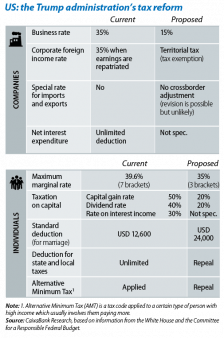As Donald Trump had promised during his electoral campaign, at the end of April his administration presented its proposed tax reform which includes extensive tax cuts. However, to the surprise of many, this included almost no measures to offset the drop in federal revenue brought about by such cuts, if approved.1 The country has a high level of public debt and a moderate budget deficit (4.4% of GDP in 2016). Given the strong fiscal conservatism of a significant faction of the Republican Party, this means that lengthy discussions and, very probably, important changes are in store for the original proposal.
The reform proposes an ambitious reduction in tax rates both for individuals and businesses. For instance, the corporate tax rate would go from the current 35% to 15%. A regional tax would also be imposed, so that profits earned by companies abroad would not have to pay tax again in the US, which would encourage large multinationals to repatriate their earnings. Regarding individuals, as well as cutting the highest marginal rate (from 39.6% to 35%) and reducing the number of brackets, the so-called alternative minimum tax would also be repealed. This alternate taxation establishes a minimum rate for those people who might be entitled to a range of deductions.
The proposed change is therefore markedly regressive. By way of example, and according to the analysis by the Tax Policy Center, while the median citizen would enjoy an average tax cut of 1.8%, those citizens with incomes in the top quintile (the 20% top earners of the population) would enjoy an average cut of 6.6%. This reduction would increase to 14.2% for the top 0.1% of citizens.2
On the other hand, the proposal would entail a significant increase in federal debt. The net revenue cost would be around USD 5.5 trillion over the next 10 years, around 3% of GDP yearly. And this would come mainly from companies (approximately 70% of the total) as the elimination of a large number of tax deductions would offset part of the cost of the large cut in tax rates for individuals. Consequently, if the Trump administration’s proposal is passed, net public debt could go from 77% of GDP to 111% by 2027. By comparison, the country’s debt level was 45% of GDP before the big crisis.3
Defenders of the plan argue that this extra cost would be compensated by higher revenue from greater economic growth, as a consequence of more incentives to work, save and invest. However, a simple calculation shows that, to offset the aforementioned fiscal cost, the US economy would have to grow by 4% every year over the next 10 years. This figure is much higher than the long-term growth estimated by the Fed, namely 1.8%, higher than the average growth achieved by the US economy since 1960, namely 3%, and even higher than Trump’s own growth forecast.
Moreover, in the current situation of almost full employment, it would be very difficult for the US economy to significantly speed up its growth rate without policies to promote gains in productivity. In fact, given the current environment, expansionary fiscal policies such as the one proposed by the Trump administration with its tax reform would very likely push up inflation, forcing the Fed to speed up its monetary normalisation and, consequently, limiting the impact of the reform on investment.
1. At the end of May, the administration presented a budget proposal for the 2018 fiscal year that specified significant reductions in certain items of expenditure. However, several of these have already caused controversy among the members of the different Houses.
2. See Tax Policy Center (2016), «An Analysis of Donald Trump’s Revised Tax Plan». This analysis, however, assumes a reduction in the maximum marginal tax rate for individuals from the current 39.6% to 33%.
3. See the note produced by the Committee for a Responsible Federal Budget in April («How Much Will Trump’s Tax Plan Cost?»). According to estimates by the Congressional Budget Office - CBO (2017), «The Budget and Economic Outlook: 2017 to 2027», if the plan is not passed, net public debt will increase to 89% in 2027.




